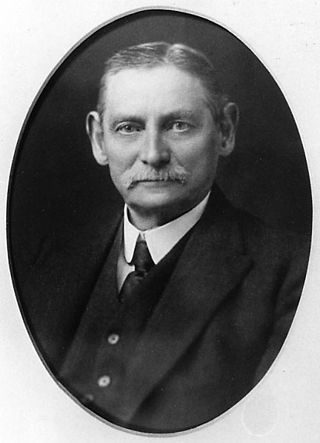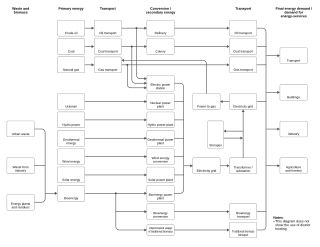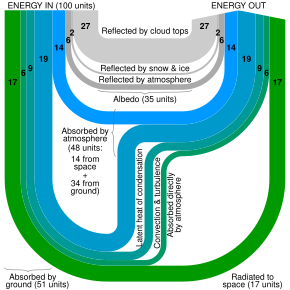Industrial ecology (IE) is the study of material and energy flows through industrial systems. The global industrial economy can be modelled as a network of industrial processes that extract resources from the Earth and transform those resources into by-products, products and services which can be bought and sold to meet the needs of humanity. Industrial ecology seeks to quantify the material flows and document the industrial processes that make modern society function. Industrial ecologists are often concerned with the impacts that industrial activities have on the environment, with use of the planet's supply of natural resources, and with problems of waste disposal. Industrial ecology is a young but growing multidisciplinary field of research which combines aspects of engineering, economics, sociology, toxicology and the natural sciences.

Information design is the practice of presenting information in a way that fosters an efficient and effective understanding of the information. The term has come to be used for a specific area of graphic design related to displaying information effectively, rather than just attractively or for artistic expression. Information design is closely related to the field of data visualization and is often taught as part of graphic design courses. The broad applications of information design along with its close connections to other fields of design and communication practices have created some overlap in the definitions of communication design, data visualization, and information architecture.

A cooling tower is a device that rejects waste heat to the atmosphere through the cooling of a coolant stream, usually a water stream, to a lower temperature. Cooling towers may either use the evaporation of water to remove heat and cool the working fluid to near the wet-bulb air temperature or, in the case of dry cooling towers, rely solely on air to cool the working fluid to near the dry-bulb air temperature using radiators.
A superheater is a device used to convert saturated steam or wet steam into superheated steam or dry steam. Superheated steam is used in steam turbines for electricity generation, in some steam engines, and in processes such as steam reforming. There are three types of superheaters: radiant, convection, and separately fired. A superheater can vary in size from a few tens of feet to several hundred feet.

Flow diagram is a collective term for a diagram representing a flow or set of dynamic relationships in a system. The term flow diagram is also used as a synonym for flowchart, and sometimes as a counterpart of the flowchart.

Data and information visualization is the practice of designing and creating easy-to-communicate and easy-to-understand graphic or visual representations of a large amount of complex quantitative and qualitative data and information with the help of static, dynamic or interactive visual items. Typically based on data and information collected from a certain domain of expertise, these visualizations are intended for a broader audience to help them visually explore and discover, quickly understand, interpret and gain important insights into otherwise difficult-to-identify structures, relationships, correlations, local and global patterns, trends, variations, constancy, clusters, outliers and unusual groupings within data. When intended for the general public to convey a concise version of known, specific information in a clear and engaging manner, it is typically called information graphics.

Charles Joseph Minard was a French civil engineer recognized for his significant contribution in the field of information graphics in civil engineering and statistics. Minard was, among other things, noted for his representation of numerical data on geographic maps, especially his flow maps.
Cleaner production is a preventive, company-specific environmental protection initiative. It is intended to minimize waste and emissions and maximize product output. By analysing the flow of materials and energy in a company, one tries to identify options to minimize waste and emissions out of industrial processes through source reduction strategies. Improvements of organisation and technology help to reduce or suggest better choices in use of materials and energy, and to avoid waste, waste water generation, and gaseous emissions, and also waste heat and noise.
Material flow analysis (MFA), also referred to as substance flow analysis (SFA), is an analytical method to quantify flows and stocks of materials or substances in a well-defined system. MFA is an important tool to study the bio-physical aspects of human activity on different spatial and temporal scales. It is considered a core method of industrial ecology or anthropogenic, urban, social and industrial metabolism. MFA is used to study material, substance, or product flows across different industrial sectors or within ecosystems. MFA can also be applied to a single industrial installation, for example, for tracking nutrient flows through a waste water treatment plant. When combined with an assessment of the costs associated with material flows this business-oriented application of MFA is called material flow cost accounting. MFA is an important tool to study the circular economy and to devise material flow management. Since the 1990s, the number of publications related to material flow analysis has grown steadily. Peer-reviewed journals that publish MFA-related work include the Journal of Industrial Ecology, Ecological Economics, Environmental Science and Technology, and Resources, Conservation, and Recycling.

Life-cycle engineering (LCE) is a sustainability-oriented engineering methodology that takes into account the comprehensive technical, environmental, and economic impacts of decisions within the product life cycle. Alternatively it can be defined as “sustainability-oriented product development activities within the scope of one to several product life cycles.” LCE requires analysis to quantify sustainability, setting appropriate targets for environmental impact. The application of complementary methodologies and technologies enables engineers to apply LCE to fulfill environmental objectives.

Material flow management (MFM) is an economic focused method of analysis and reformation of goods production and subsequent waste through the lens of material flows, incorporating themes of sustainability and the theory of a circular economy. It is used in social, medical, and urban contexts. However, MFM has grown in the field of industrial ecology, combining both technical and economic approaches to minimize waste that impacts economic prosperity and the environment. It has been heavily utilized by the country of Germany, but it has been applied to the industries of various other countries. The material flow management process utilizes the Sankey Diagram, and echoes the circular economy model, while being represented in media environments as a business model which may help lower the costs of production and waste.

Industrial symbiosis a subset of industrial ecology. It describes how a network of diverse organizations can foster eco-innovation and long-term culture change, create and share mutually profitable transactions—and improve business and technical processes.

Matthew Henry Phineas Riall Sankey was an Irish engineer and captain in the Royal Engineers, known as the creator of the Sankey diagram.

A flow map is a type of thematic map that uses linear symbols to represent movement between locations. It may thus be considered a hybrid of a map and a flow diagram. The movement being mapped may be that of anything, including people, highway traffic, trade goods, water, ideas, telecommunications data, etc. The wide variety of moving material, and the variety of geographic networks through they move, has led to many different design strategies. Some cartographers have expanded this term to any thematic map of a linear network, while others restrict its use to maps that specifically show movement of some kind.

Alluvial diagrams are a type of flow diagram originally developed to represent changes in network structure over time. In allusion to both their visual appearance and their emphasis on flow, alluvial diagrams are named after alluvial fans that are naturally formed by the soil deposited from streaming water.
Material flow cost accounting (MFCA) is a management tool that assists organizations in better understanding the potential environmental and financial consequences of their material and energy practices and seeks to improve them via changes in those practices. It does so by assessing the physical material flows in a company or a supply chain and assign adequate associated costs to these flows.

An energy system is a system primarily designed to supply energy-services to end-users. The intent behind energy systems is to minimise energy losses to a negligible level, as well as to ensure the efficient use of energy. The IPCC Fifth Assessment Report defines an energy system as "all components related to the production, conversion, delivery, and use of energy".
Techno-economic assessment or techno-economic analysis is a method of analyzing the economic performance of an industrial process, product, or service. It typically uses software modeling to estimate capital cost, operating cost, and revenue based on technical and financial input parameters. One desired outcome is to summarize results in a concise and visually coherent form, using visualization tools such as tornado diagrams and sensitivity analysis graphs.

World energy supply and consumption refers to the global supply of energy resources and its consumption. The system of global energy supply consists of the energy development, refinement, and trade of energy. Energy supplies may exist in various forms such as raw resources or more processed and refined forms of energy. The raw energy resources include for example coal, unprocessed oil & gas, uranium. In comparison, the refined forms of energy include for example refined oil that becomes fuel and electricity. Energy resources may be used in various different ways, depending on the specific resource, and intended end use. Energy production and consumption play a significant role in the global economy. It is needed in industry and global transportation. The total energy supply chain, from production to final consumption, involves many activities that cause a loss of useful energy.
Stefan Bringezu is a German environmental scientist. He has conducted pioneering research in the field of material flow analysis and derived policy-relevant indicators of resource use, which contributed to statistical standards in the EU, OECD, and UNEP and environmental footprinting across scales. He had been selected as inaugural member of the International Panel for Sustainable Resource Management and lead-coordinated in three of their reports. He was scientific director of the Center for Environmental Systems Research at Kassel University, Germany.
















